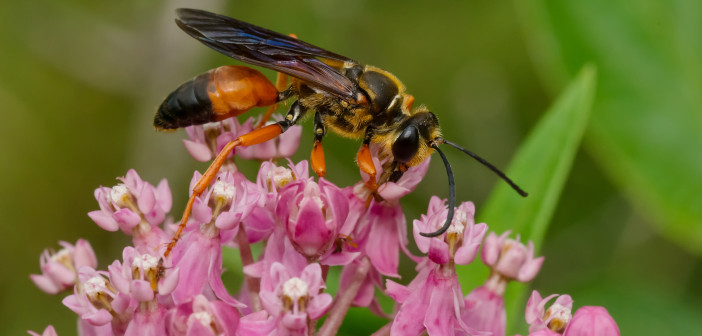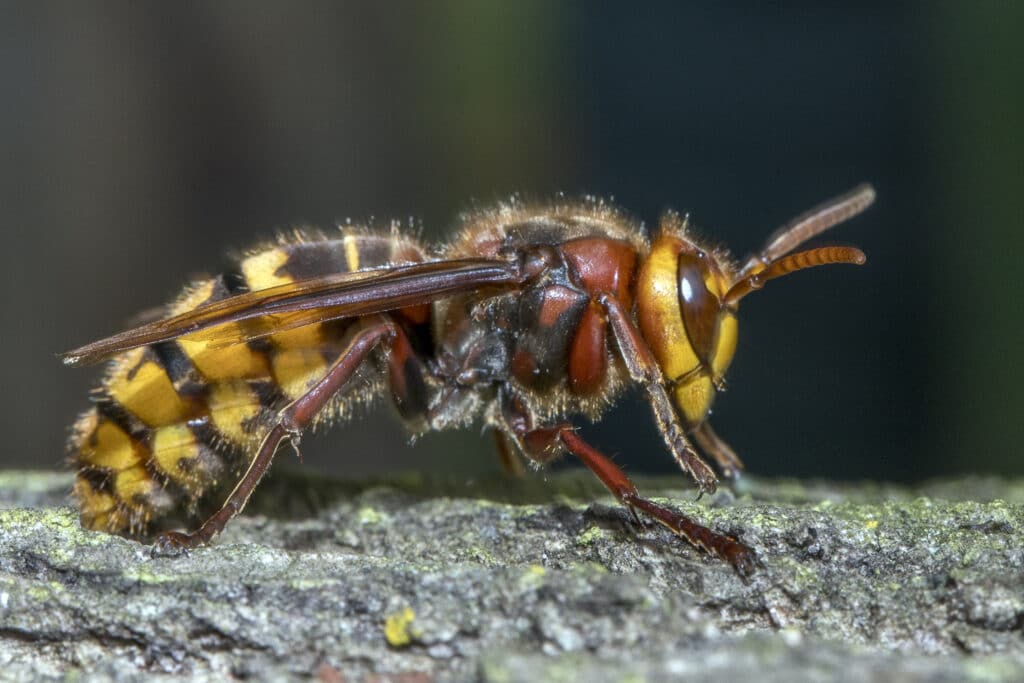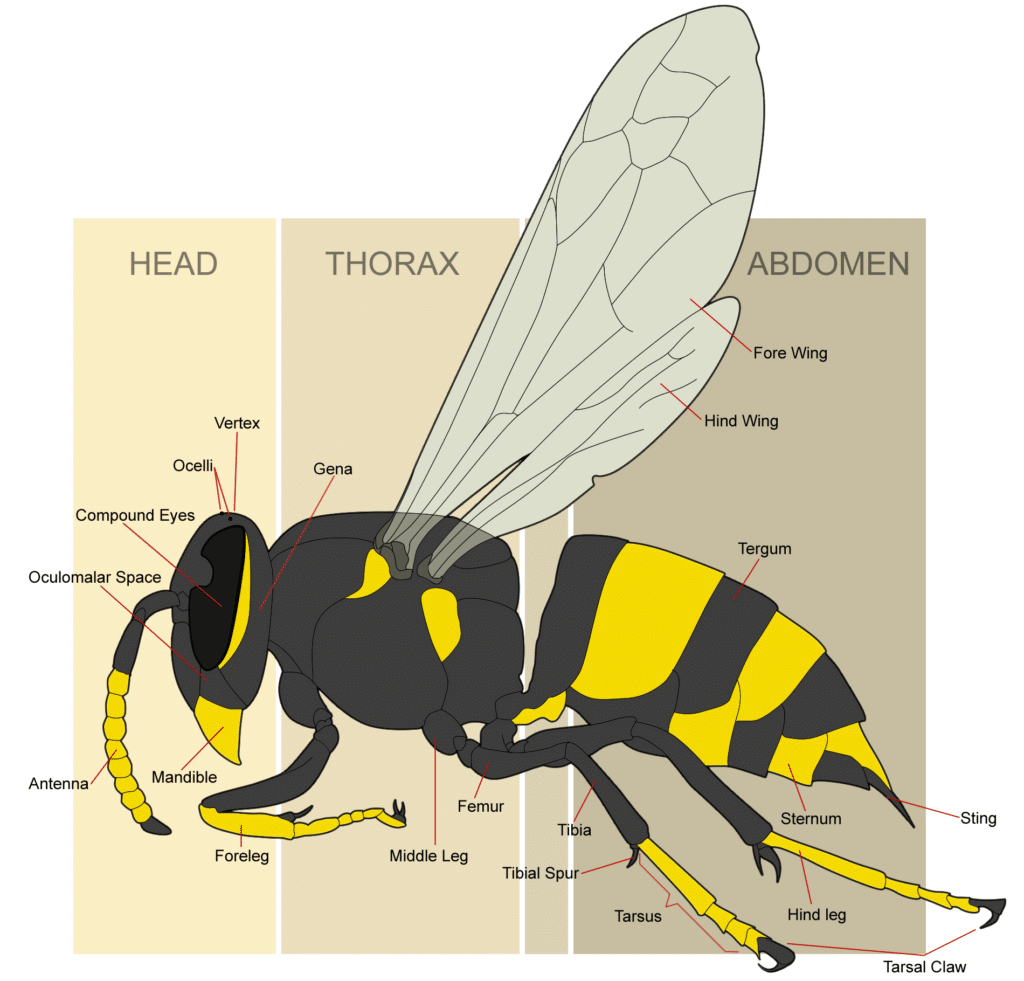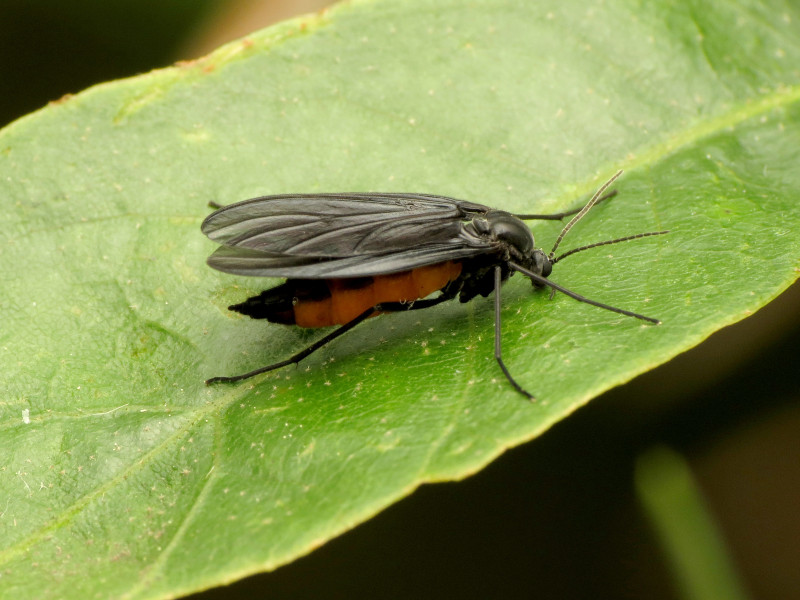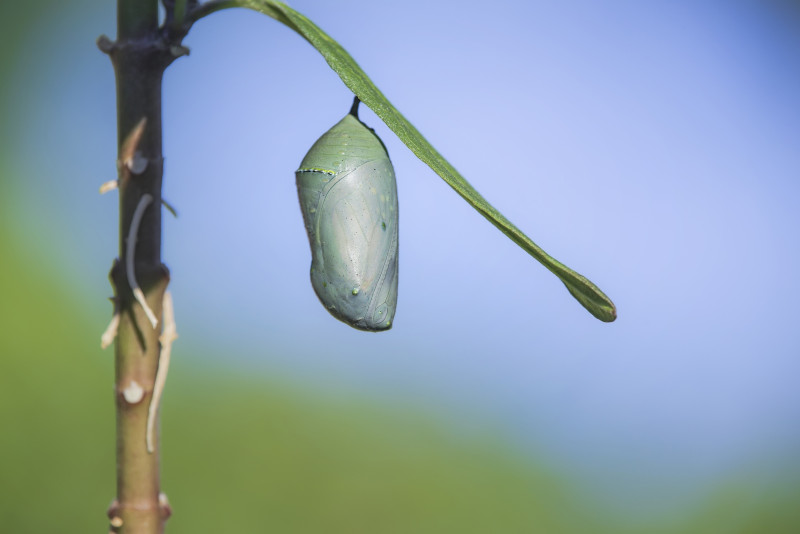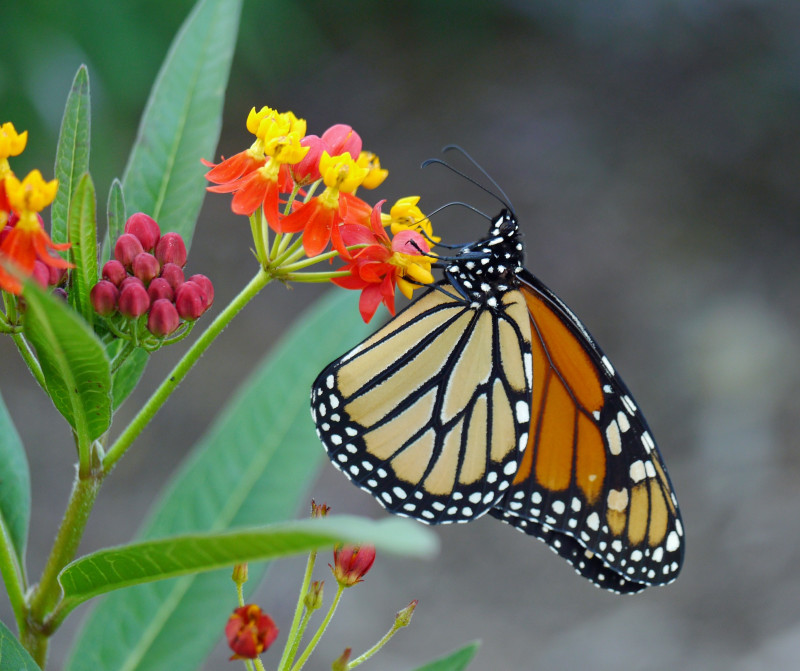Wasps deserve some respect! Numerous misconceptions surround wasps, and Aristotle may have succinctly captured some sentiments in the fourth century BC when he wrote that wasps are ” [devoid]of the extraordinary features that characterise [sic]bees,” asserting that “they have nothing divine about them.” While people may harbor a fear of bees, they also find qualities to appreciate, particularly in honeybees: the art of honey-making, their fuzzy bodies, endearing “waggle” dances, and their well-established reputation as diligent pollinators. If only wasps were cute . . . !
Behavioral ecologist and entomologist Seirian Sumner, University College London, would challenge Aristotle’s limited perspective on wasps. She asserts, “Despite their unfavorable public image, wasps play a crucial role in the world’s economy and ecosystems. Without them, the planet would be overrun by pests on a biblical scale, leading to significantly diminished biodiversity.” 1
Beneficial
She and her colleagues accumulated data from 500 scientific studies that illustrate what a broad environmental role wasps play in our world: pollination, seed dispersal, predation on pest insects, and some feed on carcasses, and their droppings are nutrients for the soil. Wasps help pollinate 960 plant species; 164, including orchids and most figs, depend on them entirely.2
Stings rarely dangerous
Despite their recognized benefits, buzzing insects can still be disconcerting, right? Even with the awareness that they’re generally just curious and unlikely to sting, their aggression spikes when they perceive a threat to themselves or their nests. In such close encounters, our instinct will prompt us to freeze, run, or swat, but the best response is to slowly walk away. Although fatal incidents from stings are extremely rare, they undeniably cause significant pain.3 (If you’re very worried about them, wear red while working in your yard—they can’t see that color.) Among the most commonly noticed wasps are hornets, paper wasps, and yellow jackets, with the former being the most aggressive about defending their nests.
Despite the bad behavior of these well-known scaremongers, they represent only 1.5 percent of the identified 100,0004 wasp species in the world. The remaining 98.5 percent are non-stinging solitary wasps, most of which go unnoticed as they fly about our gardens.
Origin
Wasps have a long evolutionary history that goes back approximately 150 million years to the Jurassic Period and originates from a common ancestor with bees and ants. Today, they’re found all over the world except for polar regions.
Largest and smallest wasps in the world
The largest social wasp in the world is the Asian Giant Hornet, up to 2.0 inches (5 cm) long and one of the so-called tarantula wasps. At the other extreme are solitary parasitic ones called fairyflies or fairy wasps, which are no more than 0.0055 inches (0.139 mm) long. The tiniest of these is also the smallest flying insect in the world, Dicopomorpha echmepterygis, at only 0.0059 inches (0.15 mm).
Largest and smallest wasps in the United States
In the U.S., the Cicada Killer Wasp, Sphecius speciosus, is the largest at 1.57 inches( 4 cm) long. The smallest is the male Dicopomorpha echmepterygis mentioned above.
Background on wasps
Wasps are a diverse group of insects belonging to the order Hymenoptera, which also includes bees and ants. There are over 30,000 identified species of wasps, and they can be found in a wide range of habitats around the world. Wasps can be broadly classified into two categories: social wasps, such as yellowjackets and hornets, which live in colonies with a structured social hierarchy, and solitary wasps, which live and operate alone.
Social wasps are known for their communal nests made of papery material, while solitary wasps often nest in the ground or in wood. Wasps play crucial roles in ecosystems, primarily as predators of other insects, which helps control pest populations, and as pollinators for various plants. Despite their sometimes fearsome reputation due to their stings, wasps contribute significantly to ecological balance and agricultural health.

(Photo credits, TOP left-right: Eastern Yellow Jacket (© Paul Reeves / Shutterstock;) Heath Sand Thread-waisted wasp (Ivar Leidus / Wiki; CC BY-SA 4.0); Ichneumon wasp sp. (Judy Gallagher / Flickr; CC BY 2.0);
MIDDLE left to right: Yellow-legged Mud Dauber (Robin Gwen Agarwal / Flickr; CC BY-NC 2.0; Great Black Wasp (Distant Hill Gardens and Nature Trail / Flickr; CC BY-NC-SA 2.0); Blue Mud Wasp (Johnny N. Dell / Bugwood; PD); BOTTOM left-right: European Hornet (Jerzy Strzelecki / Wiki; CC BY-SA 3.0); Cicada Killer Wasp (aecole2010 / Flickr; CC BY 2.0); Paper Wasp, Polistes sp. (Judy Gallagher / Flickr; CC BY 2.0)
Notable things about wasp anatomy
Wasps have four wings, like most insects, six legs, and three main body parts—the head, mesosoma (which includes the thorax and the first segment of the abdomen), and abdomen. A thin “waist,” called the petiole, joins the first and second segments of the abdomen. The petiole may be short or long, depending on the species.
Wasps have two large compound eyes plus three “simple” eyes, called ocelli, grouped in a triangle on the top of the head. Ocelli can’t focus and are mainly light sensors. They also have a proboscis for drinking. Wasps’ body coloration is highly varied—yellow, brown, black, metallic blue, and bright red, sometimes combined in markings and patterns that differ according to species—and often pretty.
Ovipositor
Females have a long tube-like ovipositor at the tip of their abdomen that, depending on the species, is modified in one of three ways:
- A stinger for injecting venom
- To pierce without venom
- For sawing
It’s also the channel through which the queen lays her eggs. Males have pseudo-stingers, which are sharp spines on their genitals; they can use them defensively by stabbing, but they carry no venom. Their mandibles are strong, used for biting and cutting, and they have a proboscis for drinking nectar. Wasps have excellent senses of smell and taste and “hear” by detecting sound waves and vibrations with sensory hairs on their antennae. Sensory hairs on other parts of their body detect vibrations and air currents.
Wasps are surprisingly intelligent: in 2023, researchers published a report5 about their ability to learn visual tasks, such as distinguishing between shades of blue and remembering human faces.6
Nests
Some nests, like those of paper wasps, look like an umbrella-shaped honeycomb, and its circular cells can be easily seen. On the other hand, hornet nests consist of a papery shell with an entry hole at the bottom. The cells are hexagonal and hidden within. And if you dare to peak in? “Danger Will Robinson!” 7. Both types can be found hanging in the open or in hollow trees, birdhouses, and other structures that provide shelter.
Some social species, such as yellow jackets, and most solitary species, tunnel underground to make their nests. Another kind of nest is that of mud dauber and potter wasps, which are made of mud.

A paper wasp queen beginning a new nest. A single egg can be seen in three of the cells. (Jayme Frye / Flickr; CC BY-NC-SA 2.0)
Nests get larger as the season goes along
Small wasp nests appear in the spring as new queens skillfully begin to build them. Nests have diverse shapes and locations and are crafted from a variety of materials. In the case of paper wasps, the chosen material is wood fiber, carefully scraped off trees, logs, fences, and other sources. Through a meticulous process, the queen chews and blends these fibers with her saliva, forming a pliable pulp that has adhesive qualities. With precision, she employs her front legs to shape the pulp into cells and strategically incorporates attachment points that will firmly adhere to a surface. This ingenious process is the key to how a nest can suspend, for instance, from a porch ceiling.

A young queen now has several workers to take over her nest duties. Common Paper Wasp, Polistes exclamans. (Alex Wild, Insects Unlocked Project / Flickr; PD)
Workers take over
After a queen has raised the first of her all-female “workers,” they take over nest-building, care of successive eggs and larvae, and all the queen’s needs. After that, her sole job is to lay eggs, and she’ll rarely, if ever, leave her nest.
Food
Adult wasps feed mainly on nectar, salivary liquids produced by their larvae, and aphid secretions. Some social wasps, however, eat fallen fruit, nectar, and dead insects. Adult predatory wasps feed mainly on other insects after subduing them with venom. Bits of insects are also fed to their larvae. The larvae of parasitic wasps feed on their hosts’ bodies.
Hibernation
In the fall, the nest starts producing males (drones) and new queens, which will leave to find mates from other colonies. After mating, the males die, a process called suicidal reproduction, or succumb to cold weather. Old queens and workers do, too, with only new queens going into hibernation (technically, they slip into a state of dormancy called diapause rather than true hibernation). They look for dark, dry places like cracks, tree crevices, rotting logs, under eaves, and attics. Some hibernate underground. During hibernation, they fold their wings and tuck their antennae between their legs.
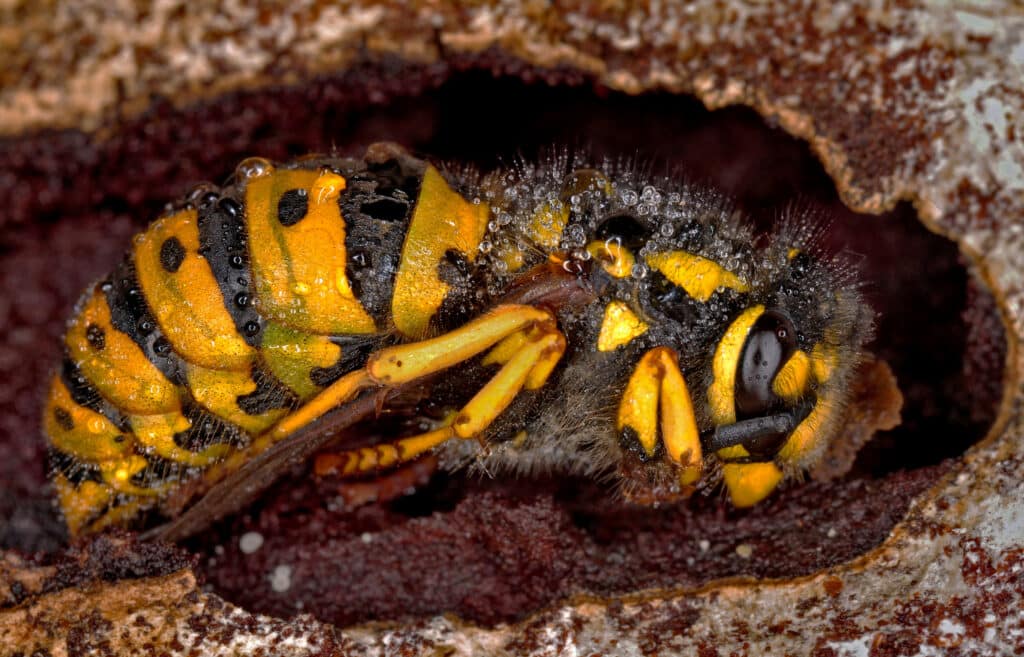
German Wasp queen, Vespula germanica, hibernating within a fallen tree (MaxNikon / Wiki; CC BY-SA 4.0)
Reproduction
Wasps go through complete metamorphosis—egg to larvae to pupa to adult—within the protection of a nest’s cell. It all begins when a queen emerges from hibernation and starts building a nest with honeycomb-like cells. She lays one egg in each cell.
Once they hatch, she feeds her larvae small bits of insects and sugary substances. After pupating for twenty-eight to forty-eight days, they’ll emerge as adult workers. Workers are always all-female and sterile. Once she has a few workers, the queen spends the rest of her life laying eggs. Workers live short lives—only twelve to twenty-four days.
Predators
Natural predators of wasps include dragonflies, hoverflies, beetles, praying mantises, robber flies, centipedes, and spiders. Large wasps will prey on smaller ones. Toads, frogs, salamanders, and birds eat them, too.
Should you remove a wasp’s nest?
Wasps are beneficial. A nest near your door, walkway, or work area may seem threatening and possibly require attention. But, if you can bring yourself to ignore it and don’t swat when they come too close. You’ll find they’ll leave you alone. Wasps aren’t interested in humans and will ignore you, too.
| 1 Laura Tangley, “Reconsidering Wasps,” NWF, August 2, 2022, https://bit.ly/3vCXoAt. |
| 2 Catherine Bente, “Wasps – Beneficial and Pollinators,” PennState Extension, June 15, 2023, https://bit.ly/48K34a9. |
| 3 There were 788 recorded deaths attributed to hornet, wasp, and bee stings from 2011 through 2021. A single sting can lead to a fatal anaphylactic reaction in individuals allergic to the venom. Non-allergic adults can typically endure up to ten stings per pound of body weight. Children up to five stings per pound. (Barish, Robert A., Arnold, Thomas, “Bee, Wasp, Hornet, and Ant Stings,” MerckManuals.com, https://bit.ly/4aR5mq8). |
| 4 Figure from NationalGeographic.com, but estimates vary wildly about the actual number of wasp species in the world, from 100,000 to one million. |
| 5 Dyer, Adrian G., Howard, Scarlett R., “Aversive reinforcement improves visual discrimination learning in free-flying wasps (Vespula vulgaris), SpringerLink.com, September 1, 2023, https://bit.ly/3vz0CFg. |
| 6 Dyer, Adrian G., Howard, Scarlett R., “Many people hate wasps, but they’re smarter than you might think – and ecologically important,” Theconversation.com, September 8, 2023, https://bit.ly/3vFBk8o. |
| 7 Iconic catchphrase from “Lost in Space,” a television series from 1965 to 1968 on CBS. |
In your yard: bees, wasps, ants
Briefs about bees and wasps
All about honeybees
In your yard: look for these common ‘bugs’

